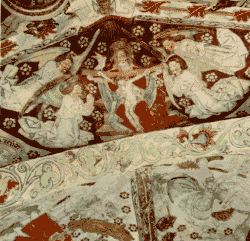Meet the Middle Ages
BackHow did they paint?

In southern Europe, the walls were decorated with a technique called "al fresco". First, the painter put wet chalk plaster on a wall on the area he intended to paint. After a quick sketch, he filled it in with colour, painting the picture before the first layer dried. He went on like this until the picture was finished. When the paint dried, it mixed with the plaster and became extremely durable. This technique took a lot of skill - the artist had to have a very clear idea of his painting, before starting on it
In northern Europe, a technique called "al secco" was used. First, the painter put wet plaster all over the wall. When it had dried, he sketched the entire picture carefully. After that, bit by bit, he dampened the wall, painted, and completed his painting in this way. This method was easier than the "al fresco"-method, but not at all as durable. With the "al secco"-method, the colours fade more rapidly because the paint is on top of the plaster and not mixed with it. Therefore, in the Nordic medieval churches, the colours of the paintings are rather faint. In the Middle Ages, however, the colours were brilliant.
The walls and ceilings of the wooden churches were painted, too. Here, the surface was primed with a layer of glue and chalk before the paint was applied. The different colours were kept separate by painting black outlines around each colour.
The painter-artisan travelled around with one or more apprentices. He worked in many places. He brought examples of his work with him, so that his customers could make a choice. This is why many similar paintings are found in different churches all over the country.
The painter made his own brushes and prepared his own paints. The brushes were made of squirrel- or horsehair. The colour-pigments were ground to a powder and then mixed with egg and glue to make a sticky paint. Famous medieval painters are Johannes Rosenrod, Johannes Iwan and Albertus Pictor.